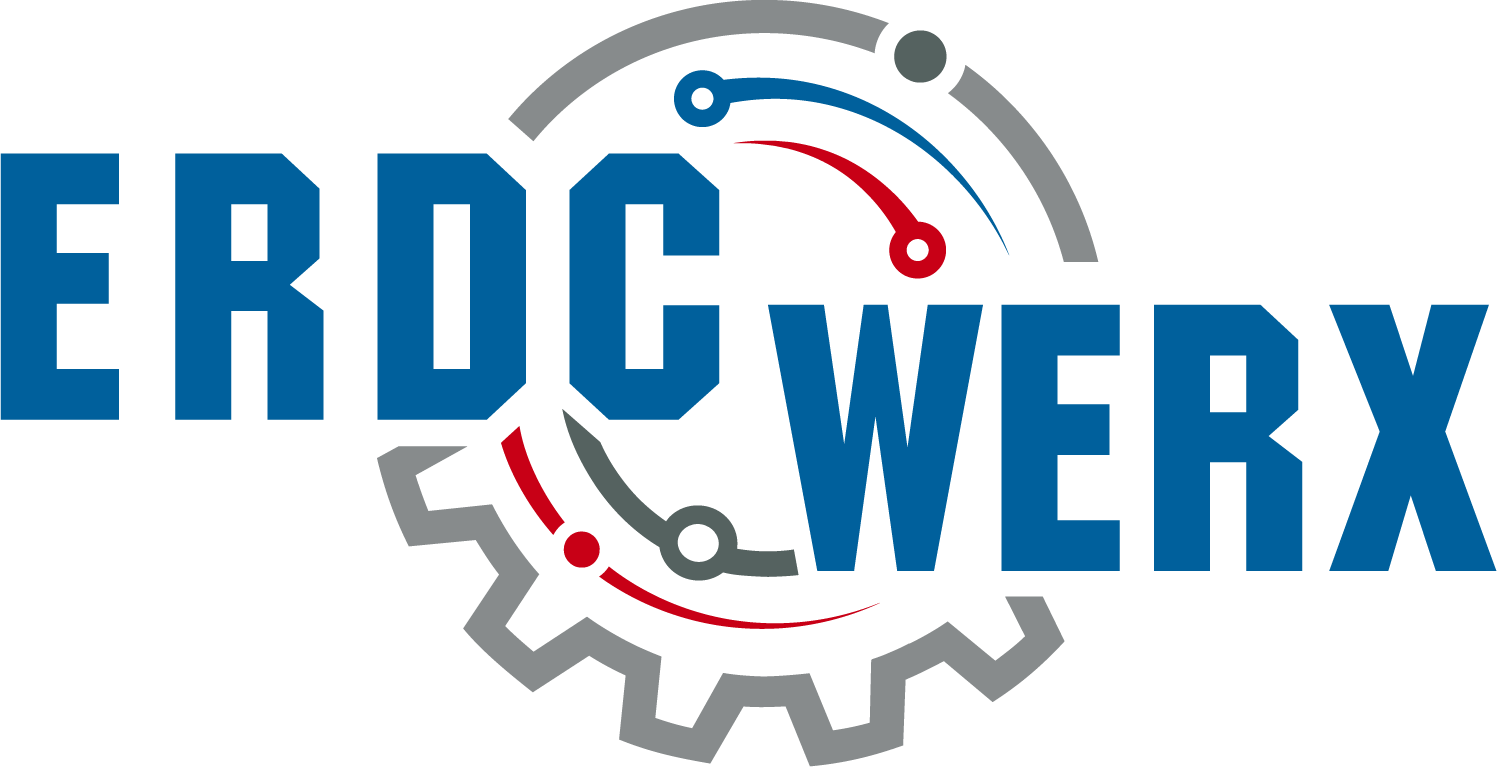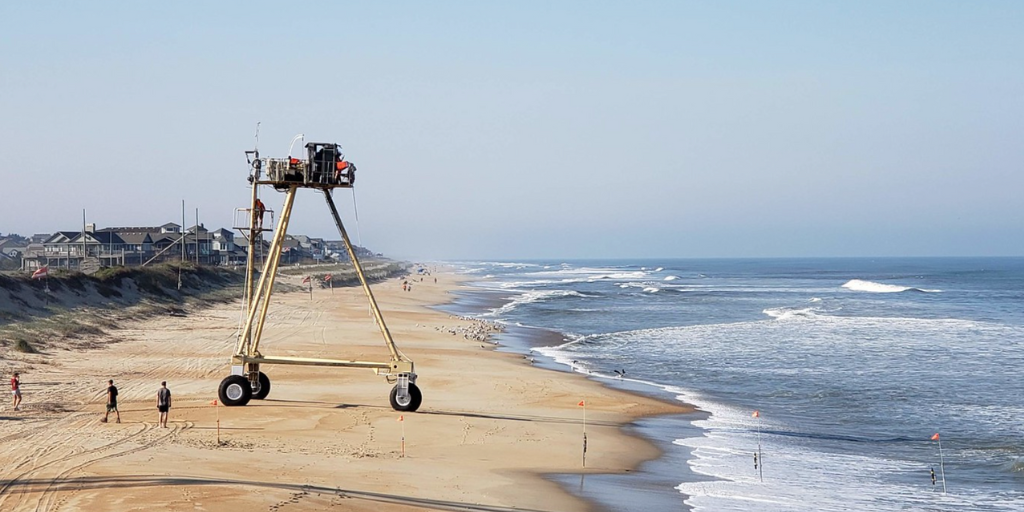Overview
ERDCWERX, in collaboration with the U.S. Army Engineer Research and Development Center (ERDC), seeks to identify a vendor capable of designing an amphibious research vehicle that meets ERDC requirements.
The Coastal Research Amphibious Buggy (CRAB, Figure 1 and 2) has been in service at the USACE Field Research Facility (FRF) since 1980. The CRAB was originally designed to be a survey vessel that could operate and collect high-quality bathymetric data in the challenging surf zone. In this role, the CRAB was functionally a mobile survey rod that could travel offshore to depths of about 9 meters in seas of up to 2-meter waves. It continues to serve in this role with updated survey technology (currently RTK GPS).


Because the CRAB was a stable, mobile platform that could operate in the surf zone, it proved to be extremely valuable for many roles at the FRF in addition to surveying. The CRAB is heavily relied on for deploying and servicing instruments in water depths up to about 9 meters (Figure 3). The FRF specializes in collecting high-quality oceanographic data in extreme weather conditions (hurricanes and nor’easters). This is done through a program of continuous measurements that rely on cabled instruments mounted on heavy steel pipes jetted into the seafloor. The FRF uses Welllog type cables (often used in the oil industry) of up to 1000 meters long and 6-meter-long steel pipes that are jetted up to 5 meters into the seafloor using the winch and Stanley pump on the CRAB (Figure 4a and 4b). Additionally, the CRAB can serve as a mobile data collection platform where scientific instruments are mounted to the CRAB which can then “park” in locations of interest and collect data (Figures 5 and 6). While the stability and mobility of the CRAB are an asset for this application, flow disturbance from the wheels and CRAB frame underwater can be limiting.

With the critical role the CRAB serves for surveying, instrument deployments and recoveries, and surf zone data collection, there is an immediate need for a replacement vehicle to ensure the uninterrupted availability of these critical capabilities. The existing CRAB has proven to be a safe and reliable platform for over 40 years. This indicates that the design and engineering of this original vehicle were done very well and should likely be incorporated into a replacement vehicle. Technological advancements may provide opportunities to improve on the original vehicle and should be explored in the design process. Safety and reliability will always be paramount in design considerations and at times may weigh proven technology over new.
View Additional CRAB Resources
Project Objective
The objective of this two-phased capability assessment is to identify vendor(s) capable of designing an amphibious research vehicle that meets ERDC requirements.
The U.S. Army Engineer Research and Development Center (ERDC) conducts coastal engineering research on surf zone hydrodynamics and coastal morphology change. This is accomplished by surveying and collecting data in the surf zone by using a specially-designed research vehicle.
Requirements
ERDC invites white papers that 1) introduce the offeror’s capabilities to design a replacement for this research vehicle; and 2) introduce initial design thoughts/concepts that address stated needs.
Current Specifications of CRAB*
Vehicle dimensions
- Width – 8 meters from outside port wheel to outside starboard wheel
- Length – ~9.3 meters back of rear wheels to front of forward wheel
- Height to base of upper platform – 10.5 meters
- Height to base of muffler under upper platform – 10.2 meters
- Maximum operable water depth – 9 meters (in 1-2 ft seas)
- Weight
- Unballasted (according to documentation, likely more with modifications) – 15,000 pounds
- Ballasted (tires filled with water/antifreeze, weight according to documentation, likely more with modifications) – 18,000 pounds
- Maximum speed on land – ~2 mph
- Maximum speed in water – ~ 1.5 mph
- Maximum wave height (according to documentation) – 2 meters
- Made of 8” Sch 80 6061 T6 Aluminum
- Wheel motors – Reidville Hydraulics & MFG – Norseman Motor Series 32-03400
- Hydraulic pump that powers wheel motors – Eaton Model 33 – Hydrostatic variable speed pump
- Eaton pump has piggybacked pump – Prince – Prince Gear PRI50050526 – that runs Stanley SM50 pump used for jetting
- Hydraulic pumps run on biodegradable hydraulic fluid
- Motor – Kubota 4 cyl Diesel – 3.769 L V3800-DI-T-E3 – Counter Clockwise rotation
- Kubota motor has port to receive piggy backed system to run hydraulic steering ram and hydraulic winch – Prince – Double pump PRISPD1B23231H9L
- 4-way tandem center flow control valves – allow isolating any individual wheel motor allowing 1, 2, or 3-wheel operation
- Cross-over relief valve – Snaptite MDDT165-15A – block-with RDC40-15A Relief Valve- prevents damage if over pressured
- Winch – Bloom Lift-Safe LS8H – 8000 lb capacity
- 3 Tires – 26 x 28L – filled with water and antifreeze
- Stainless steel hydraulic lines
Note: This list is NOT a requirements list as it applies to the brand names listed herein.
Design ProcessThe existing design has proven to be safe, stable, and reliable and it will likely be advantageous to incorporate most elements of this design into a new vehicle. To do so, it may be advantageous to thoroughly characterize the existing vehicle including stability calculations and a survey of the condition of materials after 40+ years of service. A new vehicle will meet the minimum capabilities stated below.
Meeting the minimum capabilities would result in a vehicle equivalent to or exceeding the existing CRAB. A number of potential improvements have been conceptualized by the FRF staff and are included as “Minor add-ons” and “Options to explore.” These represent potential improvements identified by science and technical staff that frequently work on or operate the CRAB. As this vehicle is designed to and frequently operates in shallow (< 3m) water and in breaking waves (up to 2 meters), rescue operations in the event of a breakdown are extremely challenging. Because of the nature of the FRF’s research, it is common to do a bathymetric survey with the CRAB when a storm is approaching and the sea state is expected to increase. This could potentially leave operators and the vehicle in jeopardy should a breakdown occur. As a result, reliability is paramount and any modifications to the existing design should result in the same or greater reliability and stability as the existing vehicle.
Minimum capabilities sought in the new design
Same or better depth capabilities
- Same or better stability characteristics – angle, sea state, currents
- 2m+ waves
- Same or better lifting capability
- Same or greater deck space on upper deck
- Same or better fuel capacity (current ~ 15 gal)
- 2 mph minimum speed on land, 1.5 mph in water
- Adjustable height crow’s nest
- Davit on upper deck
- Motor is accessible and reliable
- If hydraulic propulsion, needs to accept biodegradable hydraulic fluid
- Ability to isolate hydraulic wheel motors to maintain mobility in event of motor failure, bad fitting, etc.
- Standard workplace safety features – handrails and toe rails on upper platform, fall protection device on ladder, visibility both under and adjacent to vehicle
- Designed to last in saltwater environment – materials/corrosion prevention strategies
Minor add ons
- Cable conduits for running cables from underwater to upper platform
- Improved sensing technologies.
- Integrated tilt and roll
- Multiple RTK GPS systems
- Underwater sensing? – e.g. Lowrance active target or Garmin panoptix
- Better protected hydraulic lines – to prevent damage from impact
Options to explore
- Updated wheel motor technology – both hydraulic and other. There may be advantage of having same type as existing CRAB if new options aren’t significantly better
- Braking capability – analogous to parking break. For safety when on station.
- More upper platform space. Possible larger footprint and/or improved layout. Larger cabin.
- Increase depth capability by ~1 meter. Associated change in wheelbase and/or stability may determine feasibility.
- Increase sea state capability. This will somewhat depend on design capabilities of current. i.e. safety and recovery may already be more limiting than design limitation.
- Better crow’s nest elevator design
- Are there any options for redundant or more reliable propulsion? Breaking down in the surf is the most limiting logistics and safety concern.
- Hydrodynamic front wheel section. For more gently entry in breaking waves.
- Rinsing, flushing system to remove salt water to prevent corrosion of structure and upper deck.
- Add on capability for future options. This may mean excess hydraulic capability and mount points.
Proposed solutions can be an advanced idea or can utilize/build on existing designs/ technology. All potential solutions will be considered.
An ideal potential offeror will exhibit relevant experience and capability to design a coastal research vehicle that meets the required specifications.
Note: Submissions should NOT include confidential or proprietary details. Submissions may be shared with other ERDC teams if there is an apparent fit with other ERDC projects.
Expected Result
Phase I: ERDC gains an understanding of the market, assesses the applicability of new and existing designs for the CRAB replacement, and ascertains the experience and capability of the submitting parties. Down-selected parties will be considered for possible funding support in Phase II.
Phase II: ERDC may issue a solicitation including a performance work statement (PWS) requesting a technical proposal and the associated cost for: 1) Survey/evaluation of current CRAB – engineering-based assessment of capabilities, 2) Preliminary design to identify details of the proposed design concept. The interested parties with proposed solutions may be asked to attend a site visit (in-person or virtual) at ERDC’s Duck, North Carolina Field Office to gain an understanding of the challenge at hand. Down-selected parties will be considered for possible design funding and, if selected, will be expected to work closely with the research team during the design phase.
Evaluation Criteria
Submissions will be evaluated based on the following criteria:
- Technical Merit – Feasibility and applicability of the proposed solution
- Cost/Schedule – Preparedness and appropriateness of cost and schedule details cited
- Business Viability – Organizational capacity, years in operation, relevant specialties, and capabilities
- Prototype/Demo – Technology Readiness Level (TRL) and availability of this solution for demonstration, if needed
Submissions must be formatted as prescribed in the white paper template. Submissions will be evaluated by ERDC subject matter experts.
Anticipated Project Schedule
23 June 2022 Project Announced, Submissions Open
11 July 2022 Question Period Ends, FAQ Document Finalized
27 July 2022 Submissions Close (DEADLINE EXTENDED)
01 Aug 2022 ERDC Evaluations Complete
Aug 2022 Downselected Parties Hosted For Virtual Pitch or Site Visit (if needed)
Aug-Sep 2022 ERDC Negotiates Design Agreement(s) With Selected Parties
30 Jan 2023 Design Delivered to ERDC
*Dates may vary to accommodate project team and participant availability.
How to Participate
1. Review FAQ
2. Complete the submission form with supplemental content as appropriate (download white paper template))
Questions: Interested parties may submit questions using this form until 11 July 2022.
Submission Instructions: Qualified parties may submit by completing a submission form and uploading required documentation.
Submissions must meet stated requirements and be received no later than 3:00 pm CST on Monday, 27 July 2022.
ERDC seeks to enter into non-FAR or FAR-based agreements with Industry, Academic, and National Lab partners whose solutions are favorably evaluated by ERDC Subject Matter Experts. As such, this project is considered competitive in the same manner as a Broad Agency Announcement (BAA) or Commercial Solutions Opening (CSO), and solutions will be evaluated independently of one another primarily for technical merit. This serves dually as notification of the intent to research the feasibility of an agreement under 10 U.S. Code, Section 2371b and/or Section 2371b(f), and as notice of pre-solicitation activities IAW FAR 5.204. The requirements of DFARS 215.371-2 do not apply to acquisition of innovative items, technologies, or services under a CSO.
Additional CRAB Photos















